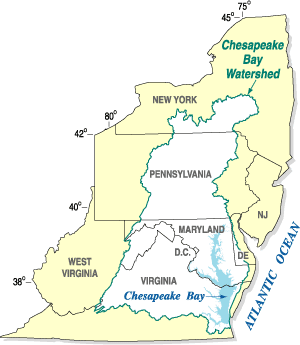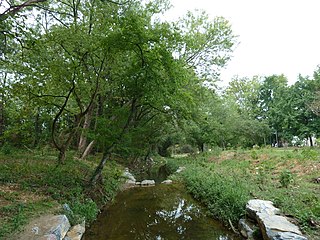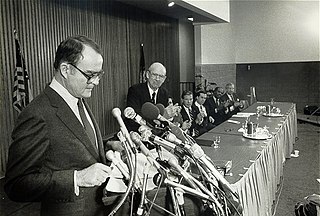Related Research Articles

The Environmental Protection Agency (EPA) is an independent executive agency of the United States federal government tasked with environmental protection matters. President Richard Nixon proposed the establishment of EPA on July 9, 1970; it began operation on December 2, 1970, after Nixon signed an executive order. The order establishing the EPA was ratified by committee hearings in the House and Senate.

The Chesapeake Bay is the largest estuary in the United States. The Bay is located in the Mid-Atlantic region and is primarily separated from the Atlantic Ocean by the Delmarva Peninsula, including parts of the Eastern Shore of Maryland, the Eastern Shore of Virginia, and the state of Delaware. The mouth of the Bay at its southern point is located between Cape Henry and Cape Charles. With its northern portion in Maryland and the southern part in Virginia, the Chesapeake Bay is a very important feature for the ecology and economy of those two states, as well as others surrounding within its watershed. More than 150 major rivers and streams flow into the Bay's 64,299-square-mile (166,534 km2) drainage basin, which covers parts of six states, New York, Pennsylvania, Delaware, Maryland, Virginia, and West Virginia, and all of Washington, D.C.
Earthjustice is a nonprofit public interest organization based in the United States dedicated to litigating environmental issues. Headquartered in San Francisco, they have an international program, a communications team, and a policy and legislation team in Washington, D.C., along with 14 regional offices across the United States.

The Clean Water Act (CWA) is the primary federal law in the United States governing water pollution. Its objective is to restore and maintain the chemical, physical, and biological integrity of the nation's waters; recognizing the responsibilities of the states in addressing pollution and providing assistance to states to do so, including funding for publicly owned treatment works for the improvement of wastewater treatment; and maintaining the integrity of wetlands.
Philip Merrill was an American diplomat, publisher, banker, and philanthropist.
Massachusetts v. Environmental Protection Agency, 549 U.S. 497 (2007), is a 5–4 U.S. Supreme Court case in which Massachusetts, along with eleven other states and several cities of the United States, represented by James Milkey, brought suit against the Environmental Protection Agency (EPA) represented by Gregory G. Garre to force the federal agency to regulate the emissions of carbon dioxide and other greenhouse gases (GHGs) that pollute the environment and contribute to climate change.
A total maximum daily load (TMDL) is a regulatory term in the U.S. Clean Water Act, describing a plan for restoring impaired waters that identifies the maximum amount of a pollutant that a body of water can receive while still meeting water quality standards.

The Chesapeake Bay Program is the regional partnership that directs and conducts the restoration of the Chesapeake Bay in the United States. As a partnership, the Chesapeake Bay Program brings together members of various state, federal, academic and local watershed organizations to build and adopt policies that support Chesapeake Bay restoration. By combining the resources and unique strengths of each individual organization, the Chesapeake Bay Program is able to follow a unified plan for restoration. The program office is located in Annapolis, Maryland.

Perdue Farms is the parent company of Perdue Foods and Perdue AgriBusiness, based in Salisbury, Maryland. Perdue Foods is a major chicken, turkey, and pork processing company in the United States. Perdue AgriBusiness ranks among the top United States grain companies. Perdue Farms has 2021 annual sales of $8 billion.

The Philip Merrill Environmental Center is a Green building owned and operated by the Chesapeake Bay Foundation. Built in 2001, the Merrill Center is located in Annapolis, Maryland on the western shore of the Chesapeake Bay. The building serves as the headquarters office building for the CBF, but is also available to rent for business and social occasions.
A New Source Review (NSR) is a permitting process created by the US Congress in 1977 as part of a series of amendments to the Clean Air Act. The NSR process requires industry to undergo an Environmental Protection Agency pre-construction review for environmental controls if they propose either building new facilities or any modifications to existing facilities that would create a "significant increase" of a regulated pollutant. The legislation allowed "routine scheduled maintenance" to not be covered in the NSR process. Since the terms "significant increase" and "routine scheduled maintenance" were never precisely defined in legislation, they have become a source of contention in many lawsuits filed by the EPA, public interest groups, and utilities.

Watts Branch is a tributary stream of the Anacostia River in Prince George's County, Maryland, and Washington, D.C.

Nutrient pollution, a form of water pollution, refers to contamination by excessive inputs of nutrients. It is a primary cause of eutrophication of surface waters, in which excess nutrients, usually nitrogen or phosphorus, stimulate algal growth. Sources of nutrient pollution include surface runoff from farm fields and pastures, discharges from septic tanks and feedlots, and emissions from combustion. Raw sewage is a large contributor to cultural eutrophication since sewage is high in nutrients. Releasing raw sewage into a large water body is referred to as sewage dumping, and still occurs all over the world. Excess reactive nitrogen compounds in the environment are associated with many large-scale environmental concerns. These include eutrophication of surface waters, harmful algal blooms, hypoxia, acid rain, nitrogen saturation in forests, and climate change.
Bradley McAllerton Campbell is an American attorney and political figure. He has served at senior levels in the United States Environmental Protection Agency (EPA) and as commissioner of the New Jersey Department of Environmental Protection (NJDEP). He is currently the President of Conservation Law Foundation (CLF), an advocacy nonprofit that forges lasting solutions to the environmental challenges for the people of New England.
American Electric Power Company v. Connecticut, 564 U.S. 410 (2011), was a United States Supreme Court case in which the Court, in an 8–0 decision, held that corporations cannot be sued for greenhouse gas emissions (GHGs) under federal common law, primarily because the Clean Air Act (CAA) delegates the management of carbon dioxide and other GHG emissions to the Environmental Protection Agency (EPA). Brought to court in July 2004 in the Southern District of New York, this was the first global warming case based on a public nuisance claim.
A stormwater fee is a charge imposed on real estate owners for pollution in stormwater drainage from impervious surface runoff.

Patrick James Morrisey is an American politician and attorney serving as the 34th Attorney General of West Virginia since 2013. He is a member of the Republican Party.

The Clean Water Rule is a 2015 regulation published by the U.S. Environmental Protection Agency (EPA) and the United States Army Corps of Engineers (USACE) to clarify water resource management in the United States under a provision of the Clean Water Act of 1972. The regulation defined the scope of federal water protection in a more consistent manner, particularly over streams and wetlands which have a significant hydrological and ecological connection to traditional navigable waters, interstate waters, and territorial seas. It is also referred to as the Waters of the United States (WOTUS) rule, which defines all bodies of water that fall under U.S. federal jurisdiction. The rule was published in response to concerns about lack of clarity over the act's scope from legislators at multiple levels, industry members, researchers and other science professionals, activists, and citizens.

United States of America v. Reserve Mining Company, 408 F. Supp. 1212, was a United States District Court for the District of Minnesota case that determined the Reserve Mining Company was responsible for amphibole asbestos fibers found in the public drinking water of Duluth, Minnesota and other North Shore (Minnesota) communities.

The Chesapeake Bay Commission is an advisory body that consults with the legislatures of Maryland, Virginia and Pennsylvania about environmental, economic and social issues related to the Chesapeake Bay. The commission is a signatory to all agreements on matters regarding the bay, and advises Congress on bay-related issues. The commission was established under state law in 1980 by the states of Maryland and Virginia. Pennsylvania joined the commission in 1985.
References
- ↑ Chesapeake Bay Foundation (CBF). Annapolis, MD. "Mission and Vision." Archived 2010-03-30 at the Wayback Machine Accessed 2010-03-26.
- ↑ "Arthur Sherwood Dies". The Washington Post. 1996-12-23.
- ↑ Jay, Peter A. (1992-04-19). "A Visit to a Deserted (by Humans) Island in the Bay". The Baltimore Sun.
- ↑ Fahrenthold, David A. (2009-01-06). "Bay Advocates Sue EPA". The Washington Post.
- ↑ Chesapeake Bay TMDL Executive Summary (PDF) (Report). EPA. 2010-12-29.
- ↑ Fears, Darryl (2011-07-24). "Alarming "dead zone" grows in the Chesapeake". The Washington Post.
- ↑ United States Court of Appeals for the Third Circuit. American Farm Bureau Federation et al v. US Environmental Protection Agency, Chesapeake Bay Foundation, et al. Case No. 13-4079. July 6, 2015.
- ↑ Fears, Darryl (2016-03-01). "Supreme Court ends challenge to the Chesapeake Bay cleanup plan". The Washington Post.
- ↑ Finley, Ben (2020-09-10). "Lawsuit: EPA fails to enforce Chesapeake Bay pollution caps". The Washington Post.
- ↑ CBF. "The Philip Merrill Center: CBF's Headquarters." Archived 2012-02-07 at the Wayback Machine Accessed 2010-03-26.
- ↑ "Will Baker, longtime CEO of Chesapeake Bay Foundation, announces retirement". Capital Gazette. Annapolis, MD. 2021-01-28.
- ↑ "Chesapeake Bay Foundation names Annapolis resident Hilary Harp Falk president and CEO". Capital Gazette. 2021-11-02.